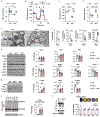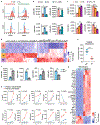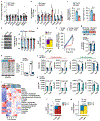Macrophage de novo NAD+ synthesis specifies immune function in aging and inflammation
- PMID: 30478397
- PMCID: PMC6768398
- DOI: 10.1038/s41590-018-0255-3
Macrophage de novo NAD+ synthesis specifies immune function in aging and inflammation
Abstract
Recent advances highlight a pivotal role for cellular metabolism in programming immune responses. Here, we demonstrate that cell-autonomous generation of nicotinamide adenine dinucleotide (NAD+) via the kynurenine pathway (KP) regulates macrophage immune function in aging and inflammation. Isotope tracer studies revealed that macrophage NAD+ derives substantially from KP metabolism of tryptophan. Genetic or pharmacological blockade of de novo NAD+ synthesis depleted NAD+, suppressed mitochondrial NAD+-dependent signaling and respiration, and impaired phagocytosis and resolution of inflammation. Innate immune challenge triggered upstream KP activation but paradoxically suppressed cell-autonomous NAD+ synthesis by limiting the conversion of downstream quinolinate to NAD+, a profile recapitulated in aging macrophages. Increasing de novo NAD+ generation in immune-challenged or aged macrophages restored oxidative phosphorylation and homeostatic immune responses. Thus, KP-derived NAD+ operates as a metabolic switch to specify macrophage effector responses. Breakdown of de novo NAD+ synthesis may underlie declining NAD+ levels and rising innate immune dysfunction in aging and age-associated diseases.
Conflict of interest statement
Competing interests
The authors declare no competing interests.
Figures








Comment in
-
NAD-biosynthetic pathways regulate innate immunity.Nat Immunol. 2019 Apr;20(4):380-382. doi: 10.1038/s41590-019-0353-x. Nat Immunol. 2019. PMID: 30858621 No abstract available.
References
Publication types
MeSH terms
Substances
Grants and funding
- DP1 DK113643/DK/NIDDK NIH HHS/United States
- R01 CA188055/CA/NCI NIH HHS/United States
- RF1 AG058047/AG/NIA NIH HHS/United States
- 1P50 AG047366 /NH/NIH HHS/United States
- R37 AA11147 /NH/NIH HHS/United States
- T32 HL094274/HL/NHLBI NIH HHS/United States
- P50 AG047366/AG/NIA NIH HHS/United States
- K12 HL120001/HL/NHLBI NIH HHS/United States
- R00 HL129474/HL/NHLBI NIH HHS/United States
- R37 AA011147/AA/NIAAA NIH HHS/United States
- 5R01CA188055 /NH/NIH HHS/United States
- 5U54DK10255603 /NH/NIH HHS/United States
- RO1AG048232 /NH/NIH HHS/United States
- 5T32HL094274 /NH/NIH HHS/United States
- 1S10RR02678001/NH/NIH HHS/United States
- P30 CA124435/CA/NCI NIH HHS/United States
- R01 AG048232/AG/NIA NIH HHS/United States
- K99 HL129474/HL/NHLBI NIH HHS/United States
- RF1AG058047 /NH/NIH HHS/United States
LinkOut - more resources
Full Text Sources
Other Literature Sources
Medical
Molecular Biology Databases

